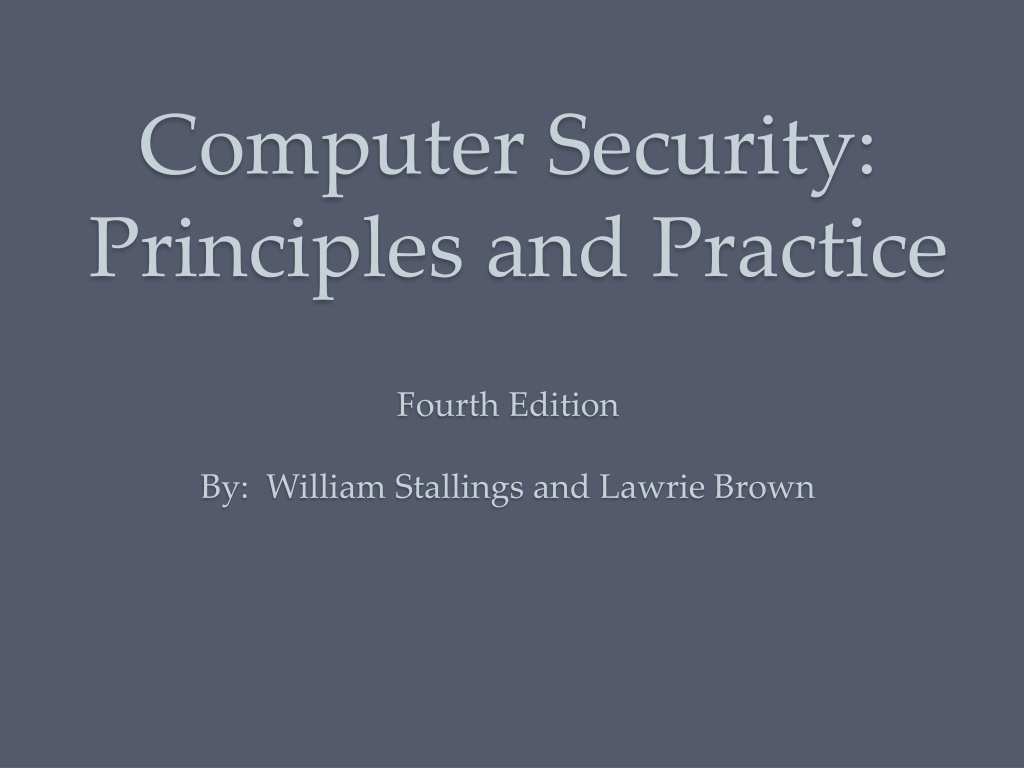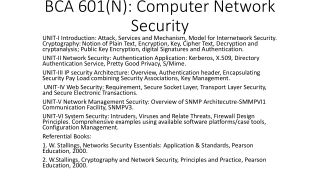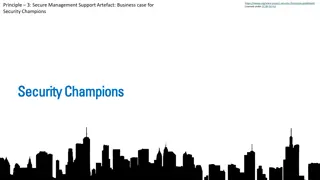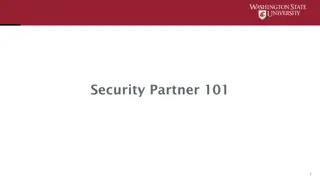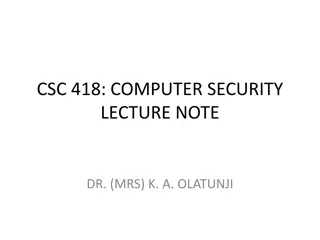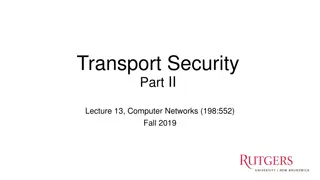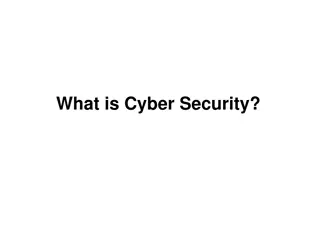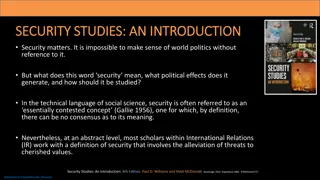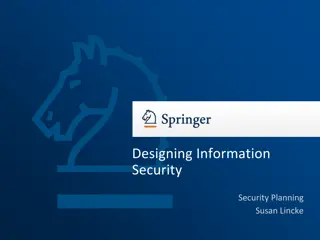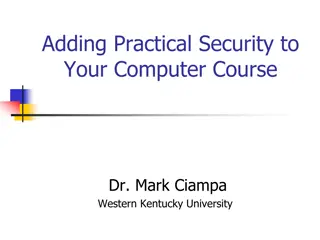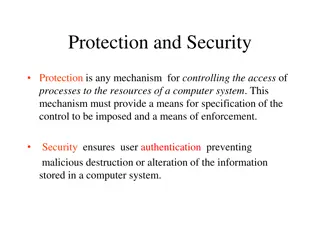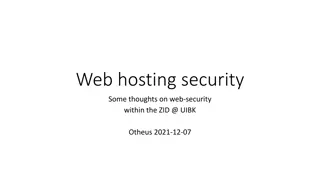Understanding Computer Security Principles and Practices
This excerpt delves into the fundamental concepts of computer security, highlighting key principles such as confidentiality, integrity, and availability. It also discusses the NIST's definition of computer security, key security concepts, levels of impact, and challenges faced in the realm of securing information systems. The content emphasizes the complexity of ensuring security in the face of potential attacks and the importance of integrating security measures early in the design process to mitigate risks effectively.
Download Presentation

Please find below an Image/Link to download the presentation.
The content on the website is provided AS IS for your information and personal use only. It may not be sold, licensed, or shared on other websites without obtaining consent from the author. Download presentation by click this link. If you encounter any issues during the download, it is possible that the publisher has removed the file from their server.
E N D
Presentation Transcript
Computer Security: Principles and Practice Fourth Edition By: William Stallings and Lawrie Brown
Chapter 1 Overview
The NIST Internal/Interagency Report NISTIR 7298 (Glossary of Key Information Security Terms , May 2013) defines the term computer security as follows: Measures and controls that ensure confidentiality, integrity, and availability of information system assets including hardware, software, firmware, and information being processed, stored, and communicated.
Key Security Concepts Confidentiality Integrity Availability Guarding against improper information modification or destruction, including ensuring information nonrepudiation and authenticity Preserving authorized restrictions on information access and disclosure, including means for protecting personal privacy and proprietary information Ensuring timely and reliable access to and use of information
Levels of Impact Low Moderate High The loss could be expected to have a severe or catastrophic adverse effect on organizational operations, organizational assets, or individuals The loss could be expected to have a limited adverse effect on organizational operations, organizational assets, or individuals The loss could be expected to have a serious adverse effect on organizational operations, organizational assets, or individuals
Computer Security Challenges 1. Computer security is not as simple as it might first appear to the novice 2. In developing a particular security mechanism or algorithm, one must always consider potential attacks on those security features 3. Procedures used to provide particular services are often counterintuitive 4. Physical and logical placement needs to be determined 5. Security mechanisms typically involve more than a particular algorithm or protocol and also require that participants be in possession of some secret information which raises questions about the creation, distribution, and protection of that secret information 6. Attackers only need to find a single weakness, while the designer must find and eliminate all weaknesses to achieve perfect security 7. Security is still too often an afterthought to be incorporated into a system after the design is complete, rather than being an integral part of the design process 8. Security requires regular and constant monitoring 9. There is a natural tendency on the part of users and system managers to perceive little benefit from security investment until a security failure occurs 10. Many users and even security administrators view strong security as an impediment to efficient and user-friendly operation of an information system or use of information
Table 1.1 Computer Security Terminology, from RFC 2828, Internet Security Glossary, May 2000 Adversary (threat agent) Individual, group, organization, or government that conducts or has the intent to conduct detrimental activities. Attack information itself. Any kind of malicious activity that attempts to collect, disrupt, deny, degrade, or destroy information system resources or the Countermeasure A device or techniques that has as its objective the impairment of the operational effectiveness of undesirable or adversarial activity, or the prevention of espionage, sabotage, theft, or unauthorized access to or use of sensitive information or information systems. Risk impacts that would arise if the circumstance or event occurs; and 2) the likelihood of occurrence. A measure of the extent to which an entity is threatened by a potential circumstance or event, and typically a function of 1) the adverse Security Policy A set of criteria for the provision of security services. It defines and constrains the activities of a data processing facility in order to maintain a condition of security for systems and data. System Resource (Asset) A major application, general support system, high impact program, physical plant, mission critical system, personnel, equipment, or a logically related group of systems. Threat reputation), organizational assets, individuals, other organizations, or the Nation through an information system via unauthorized access, destruction, disclosure, modification of information, and/or denial of service. Any circumstance or event with the potential to adversely impact organizational operations (including mission, functions, image, or Vulnerability Weakness in an information system, system security procedures, internal controls, or implementation that could be exploited or triggered by a threat source. (Table can be found on page 8 in the textbook)
Threat agents Owners value wish to abuse and/or may damage wish to minimize impose give rise to countermeasures assets to reduce to to risk threats that increase Figure 1.2 Security Concepts and Relationships
Assets of a Computer System Hardware Software Data Communication facilities and networks
Vulnerabilities, Threats and Attacks Categories of vulnerabilities Corrupted (loss of integrity) Leaky (loss of confidentiality) Unavailable or very slow (loss of availability) Threats Capable of exploiting vulnerabilities Represent potential security harm to an asset Attacks (threats carried out) Passive attempt to learn or make use of information from the system that does not affect system resources Active attempt to alter system resources or affect their operation Insider initiated by an entity inside the security parameter Outsider initiated from outside the perimeter
Countermeasures Means used to deal with security attacks Prevent Detect Recover Residual vulnerabilities may remain Goal is to minimize residual level of risk to the assets May itself introduce new vulnerabilities
Threat Consequence Threat Action (Attack) Exposure: Sensitive data are directly released to an unauthorized entity. Interception: An unauthorized entity directly accesses sensitive data traveling between authorized sources and destinations. Inference: A threat action whereby an unauthorized entity indirectly accesses sensitive data (but not necessarily the data contained in the communication) by reasoning from characteristics or byproducts of communications. Intrusion: An unauthorized entity gains access to sensitive data by circumventing a system's security protections. Unauthorized Disclosure A circumstance or event whereby an entity gains access to data for which the entity is not authorized. Table 1.2 Threat Consequences, and the Masquerade: An unauthorized entity gains access to a system or performs a malicious act by posing as an authorized entity. Falsification: False data deceive an authorized entity. Repudiation: An entity deceives another by falsely denying responsibility for an act. Deception A circumstance or event that may result in an authorized entity receiving false data and believing it to be true. Types of Threat Actions That Cause Each Incapacitation: Prevents or interrupts system operation by disabling a system component. Corruption: Undesirably alters system operation by adversely modifying system functions or data. Obstruction: A threat action that interrupts delivery of system services by hindering system operation. Disruption A circumstance or event that interrupts or prevents the correct operation of system services and functions. Usurpation A circumstance or event that results in control of system services or functions by an unauthorized entity. Consequence Based on Misappropriation: An entity assumes unauthorized logical or physical control of a system resource. Misuse: Causes a system component to perform a function or service that is detrimental to system security. RFC 4949 **Table is on page 10 in the textbook.
Computer System Computer System 4 Sensitive files must be secure (file security) Data Data 1 Access to the data must be controlled (protection) 3 Data must be securely transmitted through networks (network security) Processes representing users Processes representing users Guard Guard 2 Access to the computer facility must be controlled (user authentication) Users making requests Figure 1.3 Scope of Computer Security. This figure depicts security concerns other than physical security, including control of access to computers systems, safeguarding of data transmitted over communications systems, and safeguarding of stored data.
Table 1.3 Computer and Network Assets, with Examples of Threats Availability Confidentiality Integrity Equipment is stolen or disabled, thus denying service. An unencrypted CD- ROM or DVD is stolen. Hardware A working program is modified, either to cause it to fail during execution or to cause it to do some unintended task. Software Programs are deleted, denying access to users. An unauthorized copy of software is made. An unauthorized read of data is performed. An analysis of statistical data reveals underlying data. Existing files are modified or new files are fabricated. Data Files are deleted, denying access to users. Messages are destroyed or deleted. Communication lines or networks are rendered unavailable. Messages are modified, delayed, reordered, or duplicated. False messages are fabricated. Messages are read. The traffic pattern of messages is observed. Communication Lines and Networks
Passive and Active Attacks Active Attack Attempts to alter system resources or affect their operation Involve some modification of the data stream or the creation of a false stream Four categories: o Replay o Masquerade o Modification of messages o Denial of service Passive Attack Attempts to learn or make use of information from the system but does not affect system resources Eavesdropping on, or monitoring of, transmissions Goal of attacker is to obtain information that is being transmitted Two types: Release of message contents o Traffic analysis o
Table 1.4 Security Requirements (FIPS 200) (page 1 of 2) (Table can be found on pages 16-17 in the textbook.)
Table 1.4 Security Requirements (FIPS 200) (page 2 of 2) (Table can be found on pages 16-17 in the textbook.)
Fundamental Security Design Principles Economy of mechanism Fail-safe defaults Complete mediation Open design Separation of privilege Least common mechanism Psychological acceptability Least privilege Isolation Encapsulation Modularity Layering Least astonishment
Attack Surfaces Consist of the reachable and exploitable vulnerabilities in a system Examples: Code that processes incoming data, email, XML, office documents, and industry-specific custom data exchange formats An employee with access to sensitive information vulnerable to a social engineering attack Open ports on outward facing Web and other servers, and code listening on those ports Services available on the inside of a firewall Interfaces, SQL, and Web forms
Attack Surface Categories Network Attack Surface Software Attack Surface Human Attack Surface Vulnerabilities over an enterprise network, wide-area network, or the Internet Vulnerabilities in application, utility, or operating system code Vulnerabilities created by personnel or outsiders, such as social engineering, human error, and trusted insiders Included in this category are network protocol vulnerabilities, such as those used for a denial- of-service attack, disruption of communications links, and various forms of intruder attacks Particular focus is Web server software
Shallow Medium Security Risk High Security Risk Layering Low Medium Security Risk Deep Security Risk Small Large Attack Surface Figure 1.4 Defense in Depth and Attack Surface
Bank Account Compromise UT/U1a User surveillance User credential compromise UT/U1b Theft of token and handwritten notes Malicious software installation Vulnerability exploit UT/U2a Hidden code UT/U3a Smartcard analyzers UT/U2b Worms UT/U3b Smartcard reader manipulator UT/U2c E-mails with malicious code UT/U3c Brute force attacks with PIN calculators CC2 Sniffing User communication with attacker UT/U4a Social engineering UT/U4b Web page obfuscation Redirection of communication toward fraudulent site CC3 Active man-in-the middle attacks Injection of commands IBS1 Brute force attacks User credential guessing CC1 Pharming IBS2 Security policy violation IBS3 Web site manipulation Normal user authentication with specified session ID Use of known authenticated session by attacker CC4 Pre-defined session IDs (session hijacking) Figure 1.5 An Attack Tree for Internet Banking Authentication
Standards Standards have been developed to cover management practices and the overall architecture of security mechanisms and services The most important of these organizations are: o National Institute of Standards and Technology (NIST) NIST is a U.S. federal agency that deals with measurement science, standards, and technology related to U.S. government use and to the promotion of U.S. private sector innovation o Internet Society (ISOC) ISOC is a professional membership society that provides leadership in addressing issues that confront the future of the Internet, and is the organization home for the groups responsible for Internet infrastructure standards o International Telecommunication Union (ITU-T) ITU is a United Nations agency in which governments and the private sector coordinate global telecom networks and services o International Organization for Standardization (ISO) ISO is a nongovernmental organization whose work results in international agreements that are published as International Standards
Summary Computer security concepts o Definition o Challenges o Model Threats, attacks, and assets o Threats and attacks o Threats and assets Security functional requirements Standards Fundamental security design principles Attack surfaces and attack trees o Attack surfaces o Attack trees Computer security strategy o Security policy o Security implementation o Assurance and evaluation
